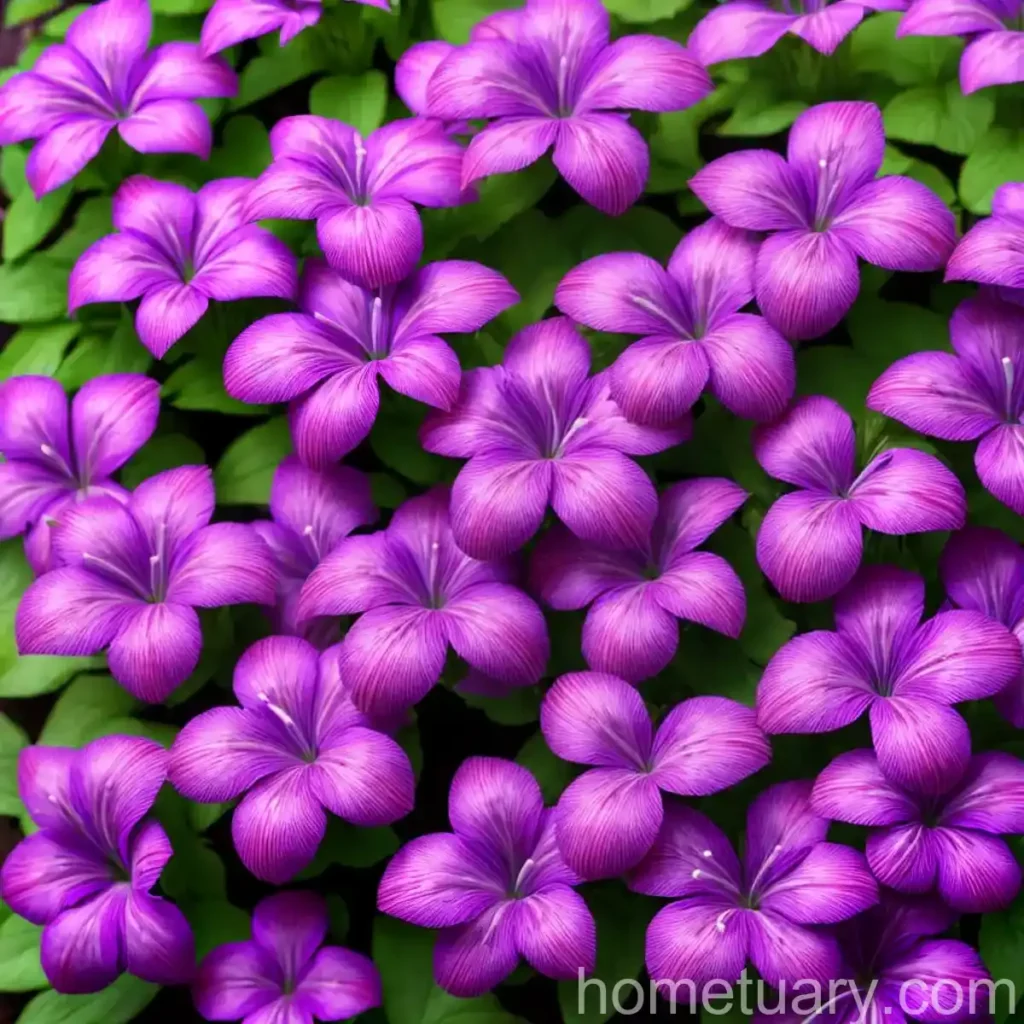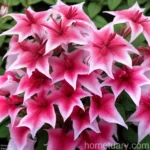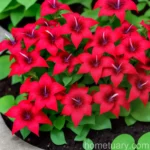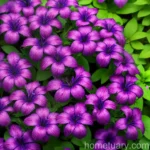Everything You Need to Know About Lobelia x speciosa ‘Russian Princess’
Lobelia x speciosa, commonly known as Russian Princess Lobelia, is a stunning perennial flowering plant that captivates with its vibrant blooms and graceful appearance. This charming plant is cherished by many gardeners for its ease of care, impressive ornamental features, and versatility in various garden settings. In this comprehensive guide, we’ll delve into the unique characteristics of Lobelia x speciosa ‘Russian Princess’ and explore the best practices for cultivating and maintaining this captivating plant.
What is Lobelia x speciosa ‘Russian Princess’?
Lobelia x speciosa ‘Russian Princess’ is a cultivated variety of Lobelia, a genus in the family Campanulaceae. This perennial plant is prized for its abundant clusters of striking, deep purple flowers that adorn the garden from midsummer to early fall. With its upright habit and lush, lance-shaped foliage, ‘Russian Princess’ adds a touch of elegance to borders, containers, and mixed perennial plantings.
Key Takeaways – Lobelia x speciosa ‘Russian Princess’
Before we delve into the specific aspects of caring for ‘Russian Princess,’ let’s establish the key takeaways related to this alluring plant. From its cultural requirements to common diseases and pests, here’s a sneak peek into the essential elements of cultivating and enjoying Lobelia x speciosa ‘Russian Princess.’
- Plant Name: Lobelia x speciosa ‘Russian Princess’
- Botanical Classification: Perennial
- Flower Color: Deep purple
- Sunlight: Full sun to partial shade
- Watering Needs: Regular moisture
- Soil Preferences: Rich, moist, well-draining soil
- Maintenance: Low to moderate
- Propagation: Division, seeds
- Common Pests: Aphids, slugs
- Common Diseases: Downy mildew, crown rot
- Hardiness Zone: 3-9
Now that we have a glimpse of the key aspects, let’s delve into the detailed care and maintenance guidelines for this enchanting perennial.
Culture
Cultivating Lobelia x speciosa ‘Russian Princess’ involves understanding its cultural preferences to provide the best growing conditions. From soil requirements to pruning techniques, each aspect contributes to the overall health and vibrancy of this captivating plant.
Sunlight
‘Russian Princess’ thrives in a location that offers full sun to partial shade. In regions with hot summers, providing some afternoon shade can help prevent the plant from wilting or becoming stressed. While it tolerates partial shade, ensure that it still receives a minimum of 4-6 hours of direct sunlight daily for optimal flowering and overall vigor.
Water
Ensuring consistent moisture is vital for the health and performance of Lobelia x speciosa ‘Russian Princess.’ While it doesn’t thrive in waterlogged conditions, the soil should never be allowed to dry out completely. Regular watering, especially during dry periods, is essential to sustain the plant’s lush foliage and prolific blooms.
Soil
The ideal soil for ‘Russian Princess’ is rich, moist, and well-draining. Amending the planting site with organic matter such as compost or well-rotted manure can improve soil structure and fertility, creating an optimal foundation for the plant to thrive. Additionally, a slightly acidic to neutral pH level (6.0-7.0) is preferred for robust growth and abundant flowering.
Fertilizer
While Lobelia x speciosa ‘Russian Princess’ appreciates nutrient-rich soil, excessive fertilization can lead to sprawling growth and decreased flowering. A balanced, slow-release fertilizer applied in early spring can provide ample nutrients for the growing season. It’s important to follow the recommended application rates to prevent overfeeding, which can compromise the plant’s overall appearance and performance.
Pruning
Pruning plays a crucial role in maintaining the compact, tidy form of Lobelia x speciosa ‘Russian Princess’ and promoting continuous flowering. Deadheading spent blooms throughout the season encourages the production of new flowers and prevents the plant from diverting energy into seed production. Additionally, cutting back the stems in late fall or early spring helps rejuvenate the plant and prepare it for a new season of growth and flowering.
Propagation
‘Russian Princess’ can be propagated through division or seeds, offering gardeners the opportunity to expand their plantings or share the beauty of this perennial with others. Division is commonly performed in early spring when new growth emerges, while collecting and sowing seeds in a controlled environment can yield new plants with characteristics similar to the parent.
Container Popularity
The compact habit and dazzling blooms of Lobelia x speciosa ‘Russian Princess’ make it a popular choice for container gardening. Whether displayed solo in a decorative pot or incorporated into mixed container plantings, ‘Russian Princess’ adds a charming accent to patios, balconies, and outdoor living spaces. When cultivating this perennial in containers, selecting a well-draining potting mix and ensuring adequate moisture are vital for sustained growth and flowering.
Common Diseases
Like many plants, Lobelia x speciosa ‘Russian Princess’ is susceptible to certain diseases that can affect its health and appearance. Understanding the common diseases and their preventive measures is essential for safeguarding the plant against potential threats.
Disease Diagnosis
One of the primary diseases that can impact ‘Russian Princess’ is downy mildew, characterized by the development of fuzzy, discolored patches on the leaves. Additionally, crown rot, often caused by waterlogged soil or poor drainage, can affect the plant’s root system and overall vigor. Regular monitoring of the foliage and prompt action upon observing any signs of disease can help prevent the spread and mitigate the impact on the plant.
Common Pests
Several pests may target Lobelia x speciosa ‘Russian Princess,’ posing potential threats to its well-being and aesthetic appeal. Vigilance and timely intervention are critical for managing these pests and protecting the plant from damage.
Pest Control
Aphids, known for their voracious feeding on plant sap, are among the common pests that can infest ‘Russian Princess.’ Regular inspection of the plant’s foliage can help detect aphid populations early, allowing for targeted control measures such as insecticidal soaps or horticultural oils. Additionally, slugs may feed on the tender foliage and flowers, requiring strategies such as barrier methods or slug baits to mitigate their impact on the plant.
Botanist’s Tips
As a plant scientist with a passion for ornamental plants, I’ve compiled a set of tips and recommendations to enhance the cultivation and enjoyment of Lobelia x speciosa ‘Russian Princess.’ These insights are based on years of experience and in-depth understanding of the plant’s needs and preferences, aimed at empowering gardeners to create stunning displays with this captivating perennial.
Fun Facts
- Lobelia x speciosa ‘Russian Princess’ is a magnet for pollinators, attracting butterflies and hummingbirds to the garden with its nectar-rich blooms.
- The vibrant flower color and graceful form of ‘Russian Princess’ make it an exquisite choice for cut flower arrangements, adding a touch of elegance to floral creations.
- This perennial’s ability to thrive in various garden settings, from borders to container plantings, showcases its versatility and adaptability as a landscape plant.
- While ‘Russian Princess’ is prized for its deep purple flowers, it also offers ornamental interest with its lush, dark green foliage, creating a visually appealing contrast in garden compositions.
Links to External Resources
To further enrich your knowledge and appreciation of Lobelia x speciosa ‘Russian Princess,’ I’ve curated a selection of authoritative resources and references that offer valuable insights, care tips, and inspiration for incorporating this captivating plant into your garden. Explore the following links to delve deeper into the world of ‘Russian Princess’ and elevate your gardening experience:
- The Royal Horticultural Society (RHS) – Lobelia x speciosa ‘Russian Princess’
- Missouri Botanical Garden – Growing Lobelia
- University of Vermont Extension – Perennial Flowers: Lobelia
- Fine Gardening – Best Lobelias for the Garden
- Royal Botanic Gardens, Kew – Plant Profiles: Lobelia x speciosa ‘Russian Princess’
By tapping into these resources, you can expand your horticultural expertise and gain valuable insights into the cultivation, care, and design possibilities associated with Lobelia x speciosa ‘Russian Princess.’ These sources serve as reliable references to support your gardening journey and encourage the successful integration of ‘Russian Princess’ into your outdoor spaces.
In conclusion, Lobelia x speciosa ‘Russian Princess’ stands out as a captivating perennial that effortlessly enhances garden landscapes with its enchanting blooms and graceful form. By incorporating the outlined guidelines and adopting best practices in its care, you can cultivate and enjoy the alluring charm of ‘Russian Princess’ in your own garden, creating a visually stunning and vibrant outdoor retreat that celebrates the beauty of nature.
Keywords: 1. Lobelia plants, 2. Lobelia speciosa, 3. Russian Princess Lobelia, 4. Lobelia x speciosa, 5. Lobelia flower, 6. Lobelia perennial, 7. Lobelia plant care, 8. Lobelia garden, 9. Lobelia Russian Princess variety, 10. Lobelia Russian Princess plant, 11. Lobelia x speciosa Russian Princess, 12. Lobelia x speciosa care tips, 13. Lobelia x speciosa Russian Princess plants, 14. Lobelia x speciosa Russian Princess flowers, 15. Lobelia x speciosa Russian Princess characteristics, 16. Lobelia x speciosa Russian Princess gardening, 17. Lobelia x speciosa Russian Princess cultivation, 18. Lobelia x speciosa Russian Princess planting, 19. Lobelia x speciosa Russian Princess maintenance, 20. Growing Lobelia x speciosa Russian Princess, 21. Lobelia x speciosa Russian Princess varieties, 22. Lobelia x speciosa Russian Princess landscaping, 23. Lobelia x speciosa Russian Princess garden design, 24. Lobelia x speciosa Russian Princess companion plants, 25. Lobelia x speciosa Russian Princess plant combinations, 26. Lobelia x speciosa Russian Princess color palette, 27. Lobelia x speciosa Russian Princess bloom time, 28. Lobelia x speciosa Russian Princess seasonality, 29. Lobelia x speciosa Russian Princess sunlight requirements, 30. Lobelia x speciosa Russian Princess soil preferences, 31. Lobelia x speciosa Russian Princess watering needs, 32. Lobelia x speciosa Russian Princess fertilizing tips, 33. Lobelia x speciosa Russian Princess pest control, 34. Lobelia x speciosa Russian Princess disease prevention, 35. Lobelia x speciosa Russian Princess propagation methods, 36. Lobelia x speciosa Russian Princess division techniques, 37. Lobelia x speciosa Russian Princess container gardening, 38. Low maintenance Lobelia x speciosa Russian Princess, 39. Lobelia x speciosa Russian Princess in borders, 40. Lobelia x speciosa Russian Princess in containers, 41. Lobelia x speciosa Russian Princess landscaping ideas, 42. Lobelia x speciosa Russian Princess plant arrangement, 43. Lobelia x speciosa Russian Princess garden design tips, 44. Lobelia x speciosa Russian Princess care guide, 45. Lobelia x speciosa Russian Princess bloom colors, 46. Lobelia x speciosa Russian Princess hardiness zone, 47. Lobelia x speciosa Russian Princess pruning techniques, 48. Lobelia x speciosa Russian Princess winter care, 49. Lobelia x speciosa Russian Princess growth habits, 50. Lobelia x speciosa Russian Princess ornamental features















